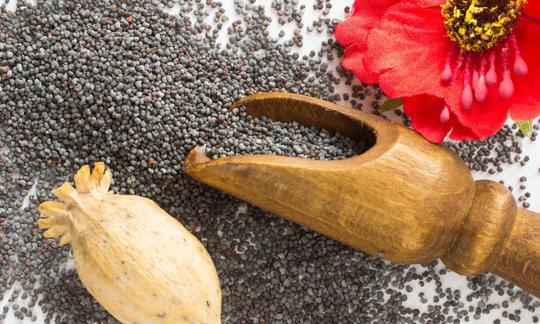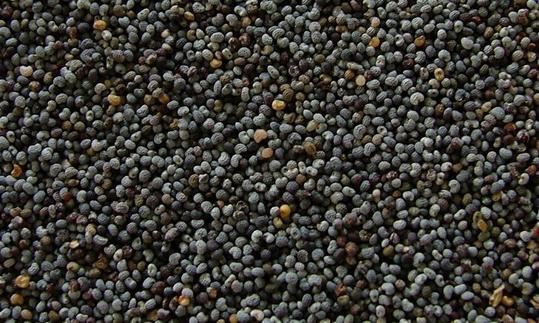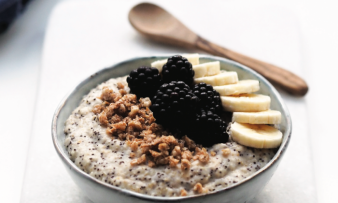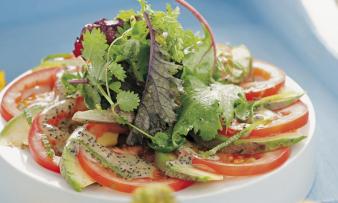Table of contents
The term poppy seed refers to the seeds of the opium poppy ( Papaver somniferum). Poppy seeds contain many healthy macronutrients, but their fatty acid ratio is questionable. Raw poppy seeds should be rinsed thoroughly with warm water before consumption and organic quality is preferable.
Use in the kitchen
The poppy seeds of the opium poppy are mostly found in desserts and baked goods such as poppy seed cakes, poppy seed strudels, poppy seed tents, poppy seed noodles or yeast dumplings, which are traditional primarily in Austria, the Czech Republic and Slovakia. The dark poppy seeds in ground form are ideal for filling these dishes (poppy seed mill or mortar). Bread rolls sprinkled with poppy seeds also taste savoury and they can also be added raw to marinades for salads, dips or sauces to refine them.
Poppy seeds are a good breakfast option: Poppy seed and lemon porridge with oat flakes covers the daily requirement offiber and is rich in manganese. Fragrant poppy seeds in muesli, bars or as a spice give the dishes a pleasant nutty taste. Ground white or yellow poppy seeds can be found in many Indian curry mixtures. These are also used ground like flour to thicken sauces.
White poppy seeds taste very nutty, grey poppy seeds are milder, and blue poppy seeds are spicier. By soaking opium poppy seeds in water, 45.6% of the free morphine and 48.4% of the free codeine can be removed. 17
The oil content of poppy seeds varies between 32% and 57%. 24 With a fat content of 40–50%, the seeds are ideal for producing cold-pressed poppy seed oil. It is always used (similar to linseed oil) just before serving and should not be heated.
Vegan recipe for fruit salad with poppy seed dressing
Ingredients (for 4 servings): ½ orange (peeled), juice of ½ orange, 1 teaspoon maple syrup, 1 teaspoon poppy seeds, 2 kiwis, 250 g dark grapes, 100 g freshraspberries, 100 g freshblueberries.
Preparation: Cut the peeled orange half into small pieces and put the orange juice from the other half into a bowl with the maple syrup and poppy seeds and mix well. Then peel the kiwis and cut into pieces. Wash the grapes and halve them. Add the berries and let everything sit for 15 minutes before eating, then serve.
Vegan recipes with poppy seeds can be found under the note: " Recipes that have the most of this ingredient ".
| Not only vegans or vegetarians should read this: Vegans often eat unhealthily. Avoidable nutritional mistakes. |
Purchasing - Storage
Whole poppy seeds are available from conventional supermarket chains such as Coop, Migros, Spar, Aldi, Rewe, Edeka, Hofer, Billa etc. These are often a mixture of grey, blue and blue-black seeds. Ground or crushed poppy seeds are mostly sold under the name "baking poppy seeds", and are often already sweetened. In selected supermarkets, organic shops, organic supermarkets ( Alnatura, Denn's Biomarkt) and health food stores, you can also get organic poppy seeds, sometimes even single-variety ones. Poppyseeds can be found in snacks or freshly baked pastries at Denner, Volg and Lidl. You can also buy white or yellow poppy seeds in specialty shops or online. Poppy seeds are available in supermarkets all year round.
The availability of poppy seeds varies depending on the size of the store, catchment area, etc. Our recorded food prices for the DA-CH countries can be found above under the ingredient image - and by clicking you can see their development at various suppliers.
Found in the wild
A related, wild-growing species is the wild corn poppy ( Papaver rhoeas), which, like the opium poppy ( Papaver somniferum), belongs to the poppy family ( Papaveraceae ). The slightly poisonous plant is not usually used, but the seeds, flowers and leaves of the wild plant are sometimes used in cooking and as a medicinal plant. 1,2 The plant genus has between 50 and 120 species worldwide, including the cultivated plant opium poppy. Those varieties with steel-blue seeds are most similar to the wild form. Wild-growing from the same family is greater celandine ( Chelidonium majus), which has an antibacterial, antiviral and slightly poisonous yellow plant sap.
Storage tips
Whole poppy seeds can be kept for several months to a year if stored in a dark, cool place and in an airtight container. Ground poppy seeds only last a few weeks. Due to the high oil content, damaged seeds spoil more quickly, which can be recognized by a rancid taste. The ground version also lasts longer when frozen.
Ingredients - Nutritional values - Calories
Poppy seeds have a very high energy content of 525 kcal/100g. This is primarily due to the high fat content, which makes up 42%. But the proportion of carbohydrates (28%) and the protein content (18%) are also considerable. 3
Eating 100 g of poppy seeds covers 335% of the daily requirement of manganese (6.7 mg/100g). Spices such as fennel seeds or dried thyme have similar values of this trace element, but we consume significantly less of them. Wheat germ has even more at 13 mg/100g. 3
The content of the macro mineral calcium is equally impressive: 1438 mg/100g of poppy seeds cover 180% of the daily requirement. Only dried spices such as oregano (1597 mg/100g) or rosemary (1280 mg/100g) offer comparable amounts. 3
Although 0.85 mg of thiamine (vitamin B1) per 100 g seems a little meager, this amount covers about 78% of the average woman's daily requirement. This compares with pulses such as lentils or soybeans, each with 0.87 mg/100g. Yeast flakes have an extremely high value of 41 mg/100g. 3
Poppy seeds also contain the essential branched-chain amino acids (BCAAs) such as leucine (1.3 g/100g), valine (1.1 g/100g) and isoleucine (0.82 g/100g). 3
The complete ingredients of poppy seeds, the coverage of the daily requirement and comparison values with other ingredients can be found in our nutrient tables. In the article Nutrients explained you will get a detailed insight into the topic.
Effects on health
Whether poppy seeds are a superfood is debatable. Although they contain an enormous variety of vitamins and trace elements, the fatty acid ratio of poppy seed oil is particularly unfavorable. The aim is to achieve a fatty acid ratio of linoleic acid to alpha-linolenic acid (LA:ALA) of almost 1:1. At 104:1, the omega-6 fatty acids, which are considered to promote inflammation, are far too high. The ratio is even worse for cashew nuts (130:1), but they contain "only" 7.8 g instead of 28 g of linoleic acid per 100 g. However, you eat more of them. In comparison, cold-pressed linseed oil has a particularly good ratio of 1:4. More on this in the health-relevant text "Vegans often eat unhealthily. Avoidable nutritional errors".
Secondary plant substances
Many of the health effects of poppy seeds can be attributed to the secondary plant substances they contain. Our article on secondary plant substances provides an overview of the classification of substance groups, their occurrence in foods and possible effects on humans. Poppy seeds contain the following secondary plant substances, among others: 17,18,25
- Alkaloids: Opium alkaloids (thebaine, codeine, morphine, papaverine, noscapine, narceine, narcotin, sanguarine, protoberberine, aporphine), rhoeadine alkaloids (rheagenine, rhoeadine, glaucamine)
- Polyphenols: Phenolic acids: hydroxybenzoic acids (gallic acid, syringic acid); flavonoids: flavanols (epicatechin), anthocyanins (pelargonidin)
However, it should be noted that the composition of secondary plant substances in poppy seeds can vary depending on the variety, time of harvest and growing conditions. Therefore, quantities are only of limited use and should only be understood roughly.
A total of 55 alkaloids were characterized by chromatography, including mainly isoquinoline alkaloids (opium alkaloids) and rhoadeine alkaloids. 25 Substances with narcotic or antispasmodic effects are the alkaloids contained in the white milky sap, such as morphine, codeine, papaverine, noscapine, thebaine and narceine. These alkaloids act on specific receptors in the brain and gastrointestinal tract. 5 The milky sap penetrates all parts of the plant except the seeds and is found in particular in the pericarp of the capsule. The ripe seeds do not contain milky sap and do not naturally contain opium alkaloids. 24
The pain-relieving effect of the opium poppy has been known in medicinal plant science for a very long time. The morphine contained in the opium poppy has been known in its pure form since 1804. Morphine is formed as an irreversible end product of the sequence: thebaine → codeine → morphine. These are secondary metabolites that occur primarily in the fully developed capsules and in the late-ripening capsule stages of the plant. As a strong painkiller, it is still used today in conventional medicine against many diseases, such as cancer or severe chronic pain. 4,16
Morphine can be addictive and an overdose can lead to respiratory depression and death. This powerful opiate is therefore subject to the Narcotics Act. By the way, morphine is much more effective than codeine. It is used for severe dry coughs. Heroin is produced by chemical derivatization (acid ester formation) of morphine and has 3-6 times the analgesic effect of morphine. Heroin itself is not contained in poppy seeds. 6,19
In various in vivo studies, noscapine and papaverine have shown anti-carcinogenic properties in breast, liver, bone, prostate and colon cancer by inhibiting cell proliferation. In one study, papaverine, together with low-frequency ultrasound, improved the function of the blood-brain barrier, which is important for the balance in the brain and can be disrupted in brain tumors. This combination lowered the levels of certain proteins and made the blood-tumor barrier more permeable. This could be a method of specifically getting chemotherapy drugs through this barrier. Another study on mice showed that papaverine significantly slowed the growth of tumors. Sanguarine and berberine also show anti-carcinogenic potential. 25
Polyphenols are natural antioxidants and are found in relatively small amounts in P. somniferum. 25
Although some preclinical study results are promising, further in vivo studies are needed to provide scientific evidence for the medicinal use of poppy plants and to avoid symptoms of poisoning. 25
Dangers - Intolerances - Side effects
The myth that poppy seeds are poisonous has long been disproven. Provided that you don't abuse them. The morphine and codeine contained in the seeds of the edible poppy are actually very small and harmless. The morphine content is reduced considerably during food processing (up to 90%). In some cases, however, contamination can occur during harvesting. If there are too many alkaloid-containing capsule fragments in the harvest, the morphine content can be increased, so health risks cannot be ruled out. 15
During pregnancy, excessive consumption of foods containing a high amount of poppy seeds is generally not recommended. 14
There are people who react allergically to opium poppy plants when they come into contact with the skin or when they ingest the seeds. However, these allergies are rather rare. The poppy seed allergen sometimes has a limited heat stability (after cooking or baking). There are cross-reactions with sesame, kiwi, rye, hazelnuts and buckwheat. 8 In general, people who are allergic to nuts and pollen can react sensitively to poppy seeds. Allergic reactions on the skin, mucous membranes, bronchi and in the gastrointestinal tract are common. 9
Risk of confusion
The opium poppy ( Papaver somniferum) can be confused with the corn poppy ( Papaver rhoeas) and the seed poppy ( Papaver dubium). All contain alkaloids, but in varying strengths. The opium poppy can usually be recognized by its flower color. The opium poppy has light purple flowers with a dark purple base inside. The entire plant is blue-green. 5 The corn poppy is known for its purple flowers. They are rarely white or purple, and the bristles stand out on the stems. Seed poppy flowers range from white to yellow to orange-red, and the stems are hairy.
Folk medicine - natural medicine
In ancient Greece, opium was used for ritual and medicinal purposes, in the Roman Empire the opium poppy was known as a drug of prosperity. In Pharaonic Egypt, opium was used to calm the cries of children and to relieve intestinal pain caused by worms. 22
Opium poppy was also used externally. Poppy was used as a balm, ointment, oil or as a thick sugar paste to treat pain, fever and the plague. The whole seeds were taken to treat diarrhea. 4 Over the course of history, more and more people used opium as a painkiller, from antiquity until Friedrich Sertürner isolated morphine at the beginning of the nineteenth century. 22
Opium and opium tinctures are known in folk medicine as a cough medicine and also as a remedy for diarrhea.
Worldwide occurrence - cultivation
The opium poppy ( Papaver somniferum) is a very old cultivated plant. Its origins lie in the eastern Mediterranean. In southern Europe, the opium poppy has been cultivated as a crop since the Neolithic period (6000 BC). Written records of its pharmaceutical use date back to 4000 BC. 11
Eighteen countries are approved by the UN to grow poppy for pharmaceutical purposes (Austria, Australia, China, France, Germany, Great Britain, Hungary, India, Japan, Macedonia, the Netherlands, New Zealand, Poland, Romania, Slovakia, Spain, Turkey and Ukraine). 24 In 2019, global poppy seed production was around 30,000 tonnes of seeds on 56,094 ha, with Turkey being the largest producer (27,288 tonnes; 54,877 ha). 18
White varieties, i.e. white poppy seeds, are mainly cultivated in India. The varieties traded in Germany are blue seeds, also called blue poppy. Small quantities of opium poppy are also produced in Germany, Austria and Switzerland. 12
Cultivation - Harvest
The legal situation for the cultivation of opium poppies is not the same everywhere. In Germany, the cultivation of poppies as a cultivated and ornamental plant requires a permit. 21 In Austria, however, poppy cultivation has an old tradition. The well-known variety "Waldviertler Grauohn" also originated there, and the name is protected. 20
Opium poppy is grown for the pharmaceutical industry and poppy seeds are produced as a by-product of the harvesting process of poppy straw. The food industry uses these poppy seeds and processes them in cakes, bread products, etc. 10
Opium poppies are harvested 5-10 days after the petals fall off for their milky sap. The dried milky sap product is known as opium, from which morphine and other alkaloids are extracted. If the plant is allowed to fully ripen, it produces poppy seeds in the capsule, which are harvested mechanically and collected by sieving. 10
Further information
Opium poppy (Papaver somniferum) takes its name from the Latin: "somniferus" means "sleep-bringing" and belongs to the poppy family (Papaveraceae). In ancient Greece, poppy was given to children as a sleeping aid.
The most important countries producing opium poppies for opium production are Afghanistan, Burma, Mexico, Laos, Pakistan and Colombia. Morphine is isolated from illegal opium and converted into heroin in makeshift production facilities. 23
Eating foods containing poppy seeds can trigger an opiate drug test, even if the amount is within the safe range. This is why poppy-containing dishes are banned in German prisons. 7
Alternative names
Opium poppy is also known as true poppy, garden poppy (but also an alternative name for Turkish poppy) and light scales. 13
The general English name for poppy is poppy, poppy seeds are poppy seeds and opium poppies are called opium poppy or garden poppy.
Other applications
Poppy seeds are not only suitable for human consumption, they are also used to enrich animal feed.
Other areas of application: Poppy seed oil from opium poppy is used as a cosmetic ingredient in the production of skin creams and soaps.
Bibliography - 25 Sources (Link to the evidence)
| 1. | Fleischhauer SG, Guthmann J et al. Essbare Wildpflanzen. 200 Arten bestimmen und verwenden. Weltbild: Augsburg. 2013. |
| 2. | Pahlow M. Das grosse Buch der Heilpflanzen. Gesund durch die Heilkräfte der Natur. Nikol Verlag: Hamburg. 2013. |
| 3. | USDA United States Department of Agriculture. |
| 4. | Zeitung de: Schlafmohn - Mohngewächs mit toller Wirkung? |
| 5. | Fleischhauer SG, Guthmann J et al. Enzyklopädie Essbare Wildpflanzen. AT Verlag: Aarau. 2018. |
| 6. | Bateman JT, Saunders SE et al. Understanding and countering opioid-induced respiratory depression. Br J Pharmacol. 2023 Apr;180(7):813-828. |
| 7. | Spiegel de: Mohnbrötchen-Verbot im Knast. 2003. |
| 8. | Alles-zur-Allergologie de: Mohnsamen. 2015. |
| 9. | Keskin O, Sekerel BE. Poppy seed allergy: A case report and review of the literature. Allergy asthma proc. 2006;27(4):396–398. |
| 10. | Carlin MG, Dean JR et al. Opium Alkaloids in Harvested and Thermally Processed Poppy Seeds. Front Chem. 2020 Aug 27;8:737. |
| 11. | Seefelder M. Opium. Eine Kulturgeschichte. Ecomed. Landsberg. 1996. |
| 12. | Statista com: Geschätzte Produktion von Opium weltweit nach Ländern in den Jahren 2005 bis 2023. 2024. |
| 13. | Heilkraeuter de: Schlafmohn. |
| 14. | BfR Bundesministerium für Risikobewertung. Erhöhte Morphingehalte in Mohnsamen: Gesundheitsrisiko nicht ausgeschlossen. 05/2006. |
| 15. | Lachenmeier DW, Sproll C et al. Poppy seed foods and opiate drug testing-where are we today? Ther Drug Monit. 2010 Feb;32(1):11-18. |
| 16. | Martínez MA, Ballesteros S. Opium poisoning in modern times. An overview. Forensic Sci Int. 2019 Sep;302:109848. |
| 17. | Lo DS, Chua TH. Poppy seeds: implications of consumption. Med Sci Law. 1992 Oct;32(4):296-302. |
| 18. | Melo D, Álvarez-Ortí M et al. Nutritional and Chemical Characterization of Poppy Seeds, Cold-Pressed Oil, and Cake: Poppy Cake as a High-Fibre and High-Protein Ingredient for Novel Food Production. Foods. 2022 Sep 29;11(19):3027. |
| 19. | Goldsack C, Scuplak SM et al. A double-blind comparison of codeine and morphine for postoperative analgesia following intracranial surgery. Anaesthesia. 1996 Nov;51(11):1029-1032. |
| 20. | Waldviertlergraumohn: at. Waldviertler Graumohn g.U. |
| 21. | BfArM Bundesinstitut für Arzneimittel und Medizinprodukte. Anbau von Schlafmohn in Deutschland. 10/2022. |
| 22. | Aragón-Poce F, Martı́nez-Fernández E et al. History of opium. In International Congress Series. Vol. 1242. Elsevier, 2002. |
| 23. | Baser KHC, Arslan N. Opium Poppy (Papaver somniferum). Medicinal and Aromatic Plants of the Middle-East. Medicinal and Aromatic Plants of the World, vol 2. Springer, Dordrecht. 2014. |
| 24. | Knutsen HK, Alexander J et al. Update of the Scientific Opinion on opium alkaloids in poppy seeds. EFSA J. 2018 May 16;16(5):e05243. |
| 25. | Butnariu M, Quispe C, Herrera-Bravo J, Pentea M, Sarac I, Küşümler AS, u. a. Papaver plants: current insights on phytochemical and nutritional composition along with biotechnological applications. Hussain T, Herausgeber. Oxidative Medicine and Cellular Longevity. Februar 2022;2022:1–23. |












Comments